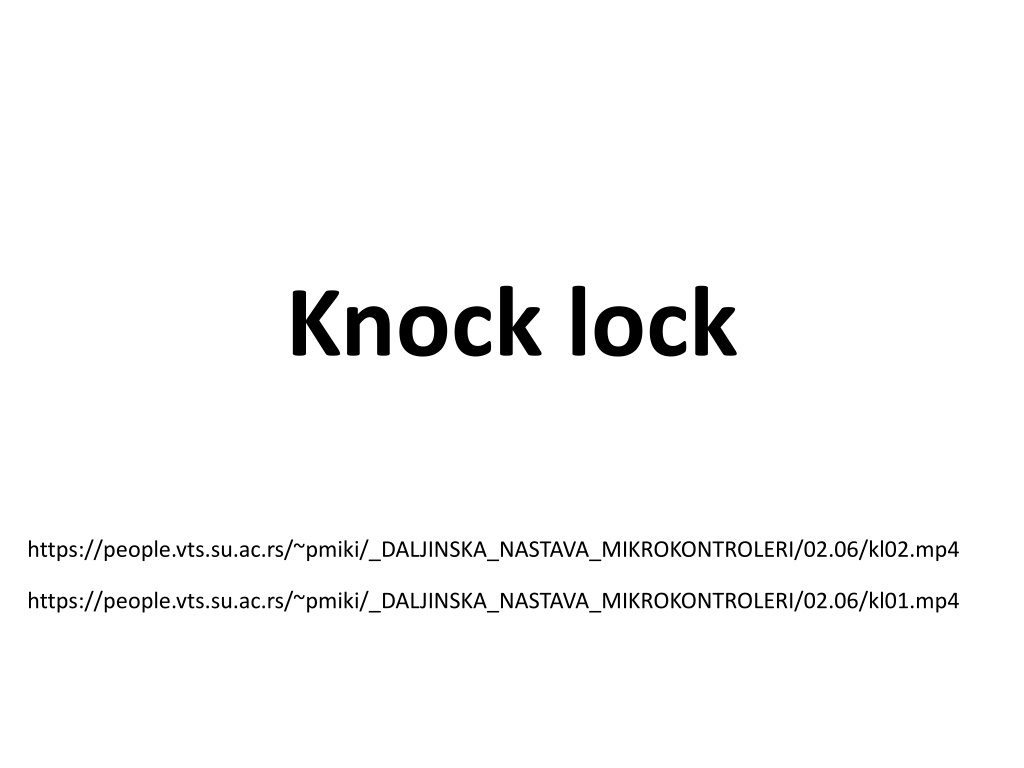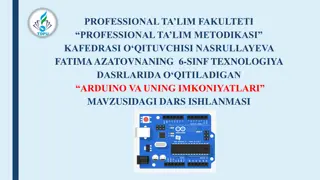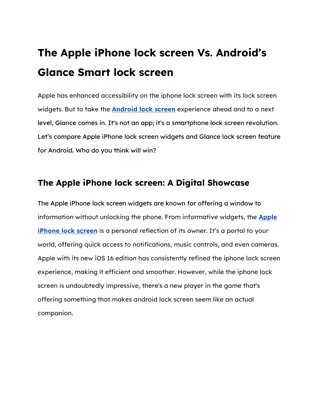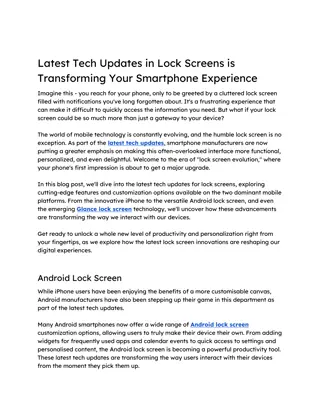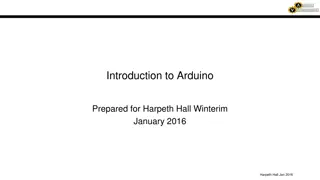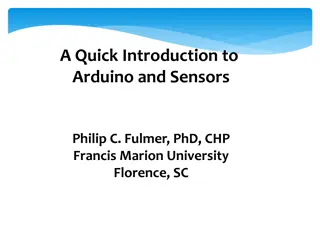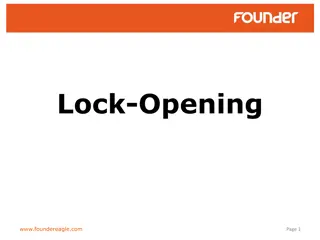Creating a Knock Lock System with Arduino
Dive into the world of Arduino microcontrollers by exploring how to build a knock lock system. From setting up the hardware to writing the code, this project will guide you through creating a security mechanism that unlocks with a specific knock pattern. Understand the servo motor, LEDs, and sensor integration to design a unique and interactive locking mechanism.
Download Presentation

Please find below an Image/Link to download the presentation.
The content on the website is provided AS IS for your information and personal use only. It may not be sold, licensed, or shared on other websites without obtaining consent from the author.If you encounter any issues during the download, it is possible that the publisher has removed the file from their server.
You are allowed to download the files provided on this website for personal or commercial use, subject to the condition that they are used lawfully. All files are the property of their respective owners.
The content on the website is provided AS IS for your information and personal use only. It may not be sold, licensed, or shared on other websites without obtaining consent from the author.
E N D
Presentation Transcript
Knock lock https://people.vts.su.ac.rs/~pmiki/_DALJINSKA_NASTAVA_MIKROKONTROLERI/02.06/kl02.mp4 https://people.vts.su.ac.rs/~pmiki/_DALJINSKA_NASTAVA_MIKROKONTROLERI/02.06/kl01.mp4
Knock lock programski kod #include <Servo.h> // create an instance of the Servo library Servo myServo; const int piezo = A0; // pin the piezo is attached to const int switchPin = 2; // pin the switch is attached to const int yellowLed = 3; // pin the yellow LED is attached to const int greenLed = 4; // pin the green LED is attached to const int redLed = 5; // pin the red LED is attached to // variable for the piezo value int knockVal; // variable for the switch value int switchVal; // variables for the high and low limits of the knock value const int quietKnock = 50; const int loudKnock = 80; // variable to indicate if locked or not boolean locked = false; // how many valid knocks you've received int numberOfKnocks = 0;
Knock lock programski kod void setup() { // attach the servo to pin 9 myServo.attach(9); // make the LED pins outputs pinMode(yellowLed, OUTPUT); pinMode(redLed, OUTPUT); pinMode(greenLed, OUTPUT); // set the switch pin as an input pinMode(switchPin, INPUT); // start serial communication for debugging Serial.begin(9600); // turn the green LED on digitalWrite(greenLed, HIGH); // move the servo to the unlocked position myServo.write(0); // print status to the Serial Monitor Serial.println("the box is unlocked!"); }
Knock lock programski kod void loop() { // if the box is unlocked if (locked == false) { // read the value of the switch pin switchVal = digitalRead(switchPin); // if the button is pressed, lock the box if (switchVal == HIGH) { // set the locked variable to "true" locked = true; // change the status LEDs digitalWrite(greenLed, LOW); digitalWrite(redLed, HIGH); // move the servo to the locked position myServo.write(90); // print out status Serial.println("the box is locked!"); // wait for the servo to move into position delay(1000); } }
Knock lock programski kod // if the box is locked if (locked == true) { // if there are three knocks if (numberOfKnocks >= 3) { // unlock the box locked = false; // check the value of the piezo knockVal = analogRead(piezo); // move the servo to the unlocked position myServo.write(0); // if there are not enough valid knocks if (numberOfKnocks < 3 && knockVal > 0) { // wait for it to move delay(20); // check to see if the knock is in range if (checkForKnock(knockVal) == true) { // change status LEDs digitalWrite(greenLed, HIGH); digitalWrite(redLed, LOW); Serial.println("the box is unlocked!"); // increment the number of valid knocks numberOfKnocks++; } // print status of knocks Serial.print(3 - numberOfKnocks); Serial.println(" more knocks to go"); // delay(1000); //en! } numberOfKnocks = 0; } } }
Knock lock programski kod // this function checks to see if a detected knock is within max and min range bool checkForKnock(int value) { // if the value of the knock is greater than the minimum, and larger // than the maximum if (value > quietKnock && value < loudKnock) { // turn the status LED on digitalWrite(yellowLed, HIGH); delay(50); digitalWrite(yellowLed, LOW); // print out the status Serial.print("Valid knock of value "); Serial.println(value); // return true return true; } // if the knock is not within range else { // print status return false; } }
